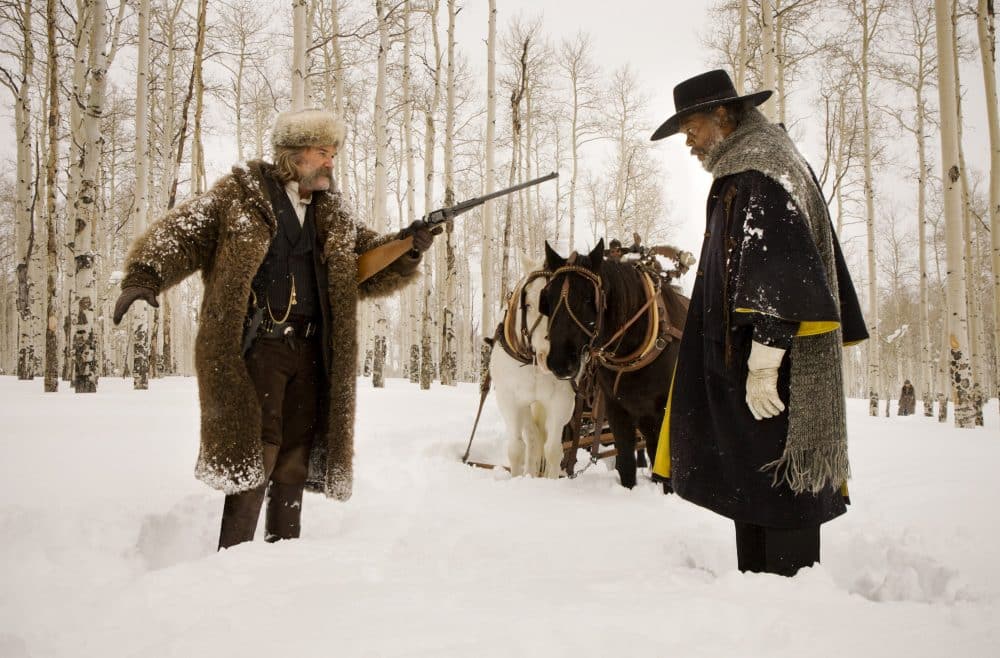(Every month, we at The Spool select a Filmmaker of the Month, honoring the life and works of influential auteurs with a singular voice, for good or ill. Given that July sees the release of Once Upon a Time in… Hollywood, the ninth film from Quentin Tarantino, we’re exploring the filmography of one of 20th-century cinema’s most breathlessly referential directors. Read the rest of our Filmmaker of the Month coverage of Tarantino here.)
It takes a while before The Hateful Eight serves up its first memorable sequence. Some context: it’s 1877, and eight strangers are trapped in a mid-sized cabin somewhere on the way to Red Rock, Wyoming, forced to take refuge from an incoming blizzard. And something’s off.
But the scene in question could have less to do with Quentin Tarantino’s Agatha Christie-esque plotting. Instead, we get to watch Samuel L. Jackson manipulate a Confederate general into getting himself killed. See, Major Marquis Wallace (Jackson) can’t just murder the unarmed old bastard (a pitch-perfect Bruce Dern) in front of a room of witnesses without risking his own freedom. So at dinner, he approaches Smithers slowly, places one of his revolvers well within arm’s reach, and tells him a story.
Some years ago, Wallace raped and killed Smithers’ son. Some years before that, Smithers executed countless black Union prisoners-of-war at the Battle of Baton Rouge. Nobody has forgotten. Nobody had moved on. Why would they? Smithers reaches for the gun. A split-second later, in an act of self-defense, one more racist lies dead.
On its own, this sequence is a showcase for the majesty of Tarantino’s period work. The flashback to Wallace’s torture of Smithers’ son is expertly edited, as the score and cinematography – along with two great thespians delivering extremely well-written dialogue – ramp up the tension slowly but surely, all to facilitate revenge-fantasy violence.
But it takes nearly an hour-and-half to get here, and when the scene ends, there’s still about an hour-and-half left. And are we really supposed to believe a man as smart as Wallace would trust the law to protect him? Or that rebel renegade and scumbag Chris Mannix (Walton Goggins) would really accept that a black man just killed one of his heroes, right in front of him?
Then, a few seconds later, Tarantino himself chimes in, revealing through voiceover narration that simultaneously, someone has poisoned the cabin’s coffee. That a storyteller as talented as Tarantino – working with an editor as good as Fred Raskin – would make such a lazy move is simply baffling.
In fact, so much of The Hateful Eight baffles me. Why use an extra-wide 70mm aspect ratio for a movie that takes place almost entirely indoors? Why recut the movie into a 4-part Netflix series three-and-a-half years later? Wasn’t the whole thing already too long?
It takes a while before The Hateful Eight serves up its first memorable sequence.
Tarantino’s last film to be distrusted by the Weinstein Company isn’t as on-the-nose in its historical revisionism as his prior outings – the brilliant Inglorious Basterds or the antebellum opus Django Unchained – or even his follow-up, the acclaimed Once Upon a Time… In Hollywood. But what The Hateful Eight gets exactly right is its treatment of the Civil War, an event so telling and traumatic that it hangs over the heads of every single character.
Credit where credit is due: two years before the travesty that was the “Unite the Right” rally in Charlottesville, Virginia, when white nationalists “demonstrated” against the removal of a racist Confederate monument, Quentin Tarantino pointed out that our national, historical wounds were far from healed. A year before the election of our Confederate-defending President, Quentin Tarantino warned: we are not over it.
It’s too bad the rest of the movie doesn’t quite measure up. Again, the runtime tests even the most patient viewer. The mystery elements, involving Jennifer Jason Leigh’s “Daisy Domergue,” are almost obligatory, and her gang of good-for-nothings (including Channing Tatum) never quite make much of an impression.
It’s also interesting watching Hateful Eight after the blowback to Sam Rockwell’s character in Martin McDonagh’s Three Billboards Outside Ebbing, Missouri and his perceived redemption, considering Tarantino gives Goggins’ character an equally offensive arc. He caps Eight on a note of hope that is at best naïve, at worst, ill-conceived and nonsensical.
At the end of the day, The Hateful Eight has never even pretended to be Tarantino’s best work. But when this movie burns bright, it more than justifies itself, and its central notion can be called downright prophetic. If only the whole measured up to the moment where that first Chekov’s gun is finally fired. It’s a shot heard round the world – or, at least, the country.

